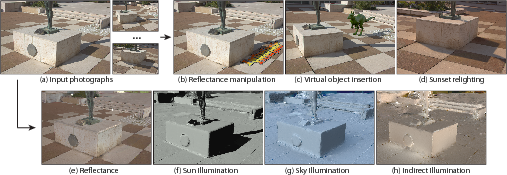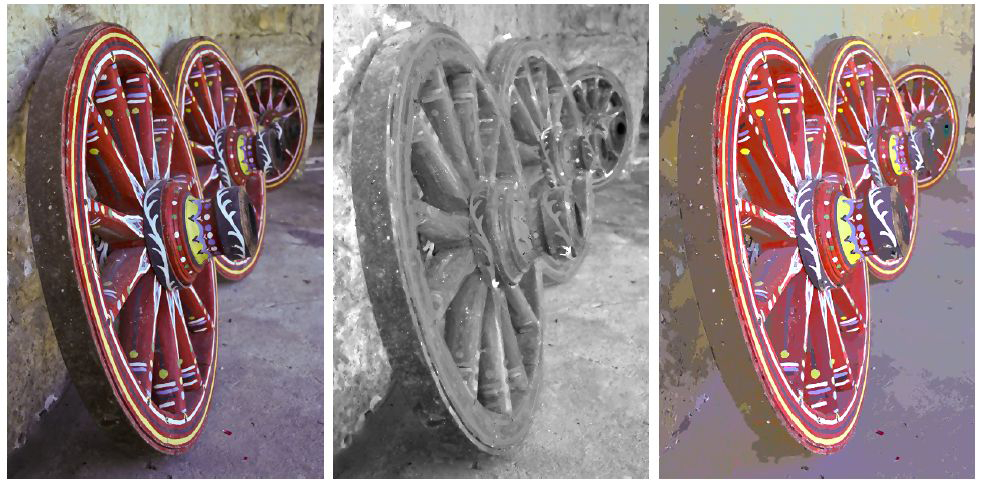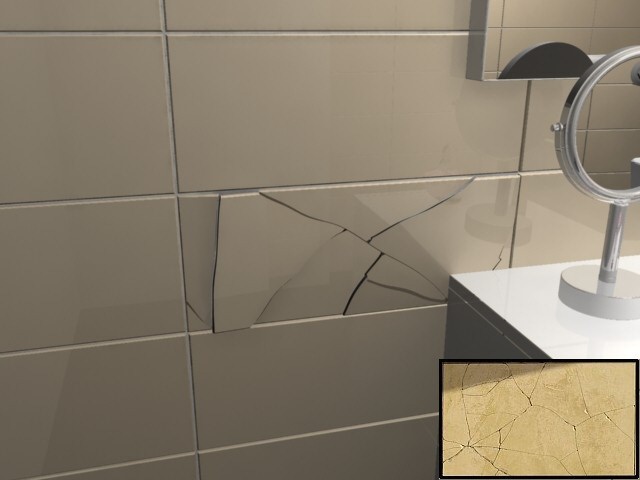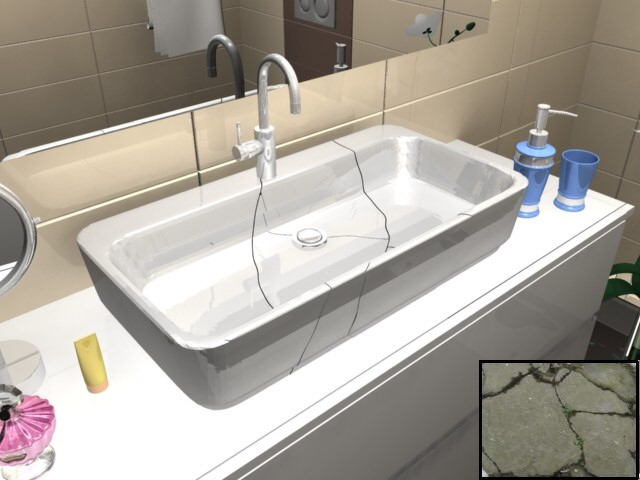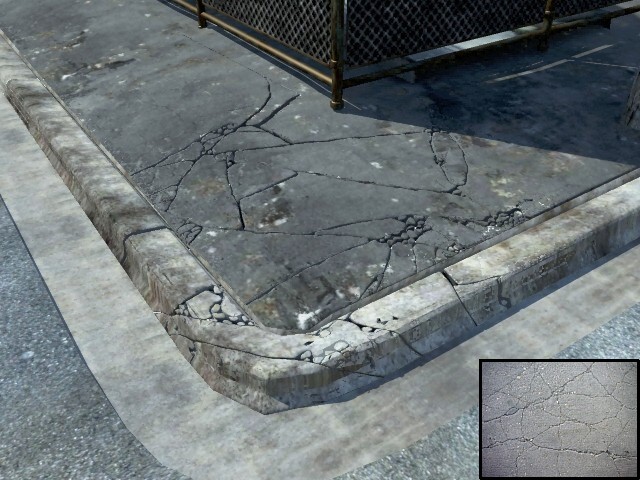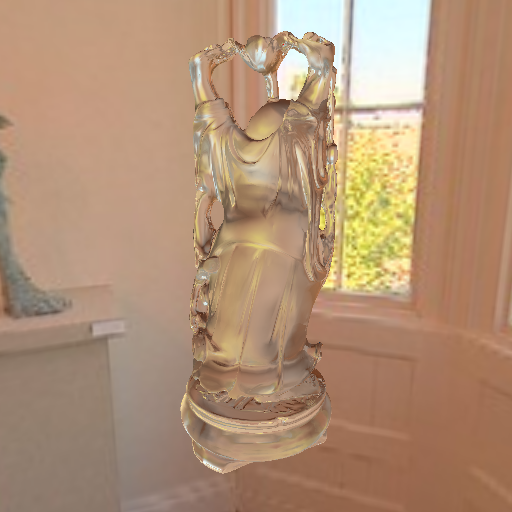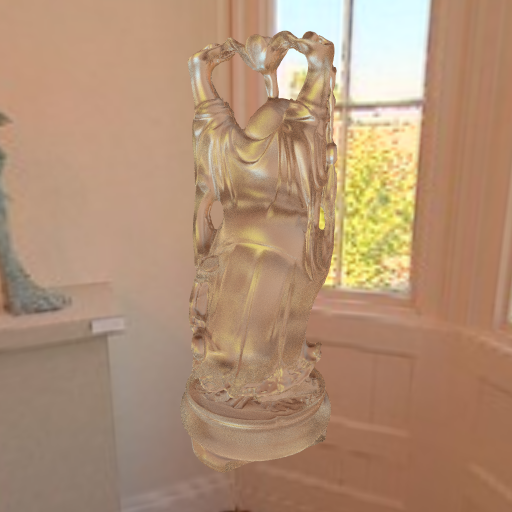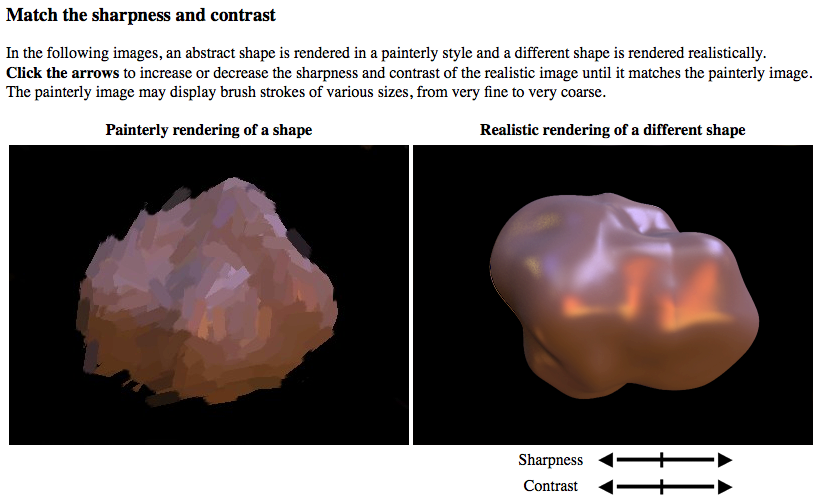Section: New Results
Plausible Image Rendering
Rich Intrinsic Image Decomposition of Outdoor Scenes from Multiple Views
Participants : Pierre-Yves Laffont, Adrien Bousseau, George Drettakis.
Intrinsic image decomposition aims at separating photographs into independent reflectance and illumination layers. We show that this ill-posed problem can be solved by using multiple views of the scene from which we derive additional constraints on the decomposition.
Our first method uses pictures from multiple views at a single time of day to automatically reconstruct a 3D point cloud of an outdoor scene. Although this point cloud is sparse and incomplete, it is sufficient to compute plausible sky and indirect illumination at each oriented 3D point, given an environment map that represents incoming distant radiance. We introduce an optimization method to estimate sun visibility over the point cloud, which compensates for the lack of accurate geometry and allows the extraction of precise cast shadows. We finally use image-guided propagation algorithms to propagate the illumination computed over the sparse point cloud to every pixel, and to separate the illumination into distinct sun, sky, and indirect components. This rich intrinsic image decomposition enables advanced image manipulations, illustrated in Figure 3 .
This work has led to the RID software (Section 5.1 ) and to a technology transfer agreement with Autodesk (Section 7.1.1.1 ). A paper will be published in the IEEE Transactions on Visualization and Computer Graphics journal [18] (in press). It has also been presented at SIGGRAPH 2012 in the Poster and Talk sessions [22] .
|
Coherent Intrinsic Images from Photo Collections
Participants : Pierre-Yves Laffont, Adrien Bousseau, George Drettakis.
We propose a second method to compute intrinsic images in the presence of varying lighting conditions. Our method exploits the rich information provided by multiple viewpoints and illuminations in an image collection to process complex scenes without user assistance, nor precise and complete geometry. Such collections can be gathered from photo-sharing websites, or captured indoors with a light source which is moved around the scene.
We use multi-view stereo to automatically reconstruct 3D points and normals, from which we derive relationships between reflectance values at different locations, across multiple views, and consequently across different lighting conditions. In addition, we propose an optimization approach which enforces coherent reflectance in all views of a scene.
The resulting coherent intrinsic images enable image-based illumination transfer between photographs of the collection, as illustrated in Figure 4 .
This work is a collaboration with Frédo Durand (MIT) and Sylvain Paris (Adobe), and started with a visit of Pierre-Yves Laffont at MIT during Summer 2011. It has been published in the ACM Transactions on Graphics journal [19] , and has been presented at SIGGRAPH Asia 2012.
|
Intrinsic Images by Clustering
Participant : Jorge Lopez Moreno.
Decomposing an input image into its intrinsic illumination and reflectance components is a long-standing ill-posed problem. We present a novel algorithm that requires no user strokes and works on a single image. Based on simple assumptions about its reflectance and luminance, we first find clusters of similar reflectance in the image, and build a linear system describing the connections and relations between them. Our assumptions are less restrictive than widely-adopted Retinex-based approaches, and can be further relaxed in conflicting situations. The resulting system is robust even in the presence of areas where our assumptions do not hold. We show a wide variety of results, including natural images, objects from the MIT dataset and texture images, along with several applications, proving the versatility of our method (see Figure 5 ).
|
This work is a collaboration with Elena Garces, Adolfo Munoz and Diego Gutierrez from University of Zaragoza (Spain). The work was published in an special issue of the journal Computer Graphics Forum and presented at the Eurographics Symposium on Rendering 2012 [16] .
Relighting for Image Based Rendering
Participants : Sylvain Duchêne, Jorge Lopez Moreno, Stefan Popov, George Drettakis.
Image-based rendering generates realistic virtual images from a small set of photographs. However, while current methods can simulate novel viewpoints from the input pictures, they cannot produce novel illumination conditions that differ from the lighting at the time of capture. The goal of this project is to provide such relighting capabilities. Our method first rely on multi-view stereo algorithms to estimate a coarse geometry of the scene. This geometry is often innacurate and incomplete. We complement it with image-based propagation algorithms that fill-in the missing data using the high-resolution input pictures. This combination of geometric and image-based cues allows us to generate plausible shadow motion and simulate novel sun directions.
Depth Synthesis and Local Warps for Plausible Image-based Navigation
Participants : Gaurav Chaurasia, Sylvain Duchêne, George Drettakis.
Modern multi-view stereo algorithms can estimate 3D geometry from a small set of unstrcutured photographs. However, the 3D reconstruction often fails on vegetation, vehicles and other complex geometry present in everyday urban scenes. We introduce a new Image-Based Rendering algorithm that is robust to unreliable geometry. Our algorithm segments the image into superpixels, synthesizes depth in superpixels with missing depth, warps them using a shape-preserving warp and blends them to create real-time plausible novel views for challenging target scenes, resulting in convincing immersive navigation experience.
This work is in collaboration with Dr. Olga Sorkine at ETH Zürich. and has been submitted to ACM Transactions on Graphics.
Perception of Slant for Image-Based Rendering
Participants : Christian Richardt, Peter Vangorp, George Drettakis.
Image-based rendering can create images with a high level of realism using simple geometry. However, as soon as the viewer moves away from the correct viewpoint, the image appears deformed. This work investigates the parameters which influence the perception of these image deformations. We propose a novel model of slant perception, which we validate using psychophysical experiments.
This work is a collaboration with Peter Vangorp at MPI Informatik, and Emily Cooper and Martin Banks from the University of California, Berkeley; in the context of the Associate Team CRISP (see also Section 8.3.1.1 ).
Lightfield Editing
Participant : Adrien Bousseau.
Lightfields capture multiple nearby views of a scene and are consolidating themselves as the successors of conventional photographs. As the field grows and evolves, the need for tools to process and manipulate lightfields arises. However, traditional image manipulation software such as Adobe Photoshop are designed to handle single views and their interfaces cannot cope with multiple views coherently. In this work we evaluate different user interface designs for lightfield editing. Our interfaces differ mainly in the way depth is presented to the user and build uppon different depth perception cues.
This work is a collaboration with Adrian Jarabo, Belen Masia and Diego Gutierrez from Universidad de Zaragoza and Fabio Pellacini from Sapienza Università di Roma.
Example‐Based Fractured Appearance
Participants : Carles Bosch, George Drettakis.
A common weathering effect is the appearance of cracks due to material fractures. Previous exemplar-based aging and weathering methods have either reused images or sought to replicate observed patterns exactly. We propose an approach to exemplar-based modeling that creates weathered patterns by matching the statistics of fracture patterns in a photograph. We conducted a user study to determine which statistics are correlated to visual similarity and how they are perceived by the user. We describe a physically-based fracture model capable of producing similar crack patterns at interactive rates and an optimization method to determine its parameters based on key statistics of the exemplar. Our approach is able to produce a variety of fracture effects from simple crack photographs at interactive rates, as shown in Figure 6 .
|
This work is a collaboration with Loeiz Glondu, Maud Marchal and George Dumont from IRISA-INSA/Inria Rennes - Bretagne Atlantique, Lien Muguercia from the University of Girona, and Holly Rushmeier from Yale University. The work was published in the Computer Graphics Forum journal and presented at the 23rd Eurographics Symposium on Rendering [17] .
Real-Time Rendering of Rough Refraction
Participant : Adrien Bousseau.
We propose an algorithm to render objects made of transparent materials with rough surfaces in real-time, under all-frequency distant illumination. Rough surfaces cause wide scattering as light enters and exits objects, which significantly complicates the rendering of such materials. We present two contributions to approximate the successive scattering events at interfaces, due to rough refraction: First, an approximation of the Bidirectional Transmittance Distribution Function (BTDF), using spherical Gaussians, suitable for real-time estimation of environment lighting using pre-convolution; second, a combination of cone tracing and macro-geometry filtering to efficiently integrate the scattered rays at the exiting interface of the object. We demonstrate the quality of our approximation by comparison against stochastic ray-tracing (see Figure 7 ). Furthermore we propose two extensions to our method for supporting spatially varying roughness on object surfaces and local lighting for thin objects.
|
This work is a collaboration with Charles De Rousiers , Kartic Subr, Nicolas Holzschuch from Inria Grenoble, and Ravi Ramamoorthi from UC Berkeley in the context of the Associate Team CRISP (see also Section 8.3.1.1 ). A paper describing the method was published in the IEEE Transactions on Visualization and Computer Graphics journal [14] .
Gabor Noise by Example
Participants : Ares Lagae, George Drettakis.
Procedural noise is a fundamental tool in Computer Graphics. However, designing noise patterns is hard. In this project, we propose Gabor noise by example, a method to estimate the parameters of bandwidth-quantized Gabor noise, a procedural noise function that can generate noise with an arbitrary power spectrum, from exemplar Gaussian textures, a class of textures that is completely characterized by their power spectrum (see Figure 8 ).
More specifically, we introduce (i) bandwidth-quantized Gabor noise, a generalization of Gabor noise to arbitrary power spectra that enables robust parameter estimation and efficient procedural evaluation; (ii) a robust parameter estimation technique for quantized-bandwidth Gabor noise, that automatically decomposes the noisy power spectrum estimate of an exemplar into a sparse sum of Gaussians using non-negative basis pursuit denoising; and (iii) an efficient procedural evaluation scheme for bandwidth-quantized Gabor noise, that uses multi-grid evaluation and importance sampling of the kernel parameters. Gabor noise by example preserves the traditional advantages of procedural noise, including a compact representation and a fast on-the-fly evaluation, and is mathematically well-founded.
|
This work is a collaboration with Bruno Galerne from MAP5, Université Paris Descartes and CNRS, Sorbonne Paris Cité; Ares Lagae from KU Leuven; and Sylvain Lefebvre from the ALICE project team, Inria Nancy - Grand Est. This work was presented at SIGGRAPH 2012 and published in ACM Transactions on Graphics [15] .
Structured Gabor noise
Participants : Gaurav Chaurasia, Ares Lagae, George Drettakis.
Current procedural noise synthesis techniques [15] are limited to Gaussian random field textures. This project aims to generalize procedural noise to a broader class of structured textures.
This work is in collaboration with Dr. Ares Lagae (Katholieke Universiteit Leuven, Belgium), Dr. Bruno Galerne (Université Paris Descartes) and Prof. Ravi Ramamoorthi (UC Berkeley), in the contect of the Associate Team CRISP (Section 8.3.1.1 ).
Gloss Perception in Painterly and Cartoon Rendering
Participant : Adrien Bousseau.
Depictions with traditional media such as painting and drawing represent scene content in a stylized manner. It is unclear however how well stylized images depict scene properties like shape, material and lighting. In this project, we use non photorealistic rendering algorithms to evaluate how stylization alters the perception of gloss (see Figure 9 ). Our study reveals a compression of the range of representable gloss in stylized images so that shiny materials appear more diffuse in painterly rendering, while diffuse materials appear shinier in cartoon images.
From our measurements we estimate the function that maps realistic gloss parameters to their perception in a stylized rendering. This mapping allows users of NPR algorithms to predict the perception of gloss in their images. The inverse of this function exaggerates gloss properties to make the contrast between materials in a stylized image more faithful. We have conducted our experiment both in a lab and on a crowdsourcing website. While crowdsourcing allows us to quickly design our pilot study, a lab experiment provides more control on how subjects perform the task. We provide a detailed comparison of the results obtained with the two approaches and discuss their advantages and drawbacks for studies like ours.
This work is a collaboration with James O'Shea, Ravi Ramamoorthi and Maneesh Agrawala from UC Berkeley in the context of the Associate Team CRISP (see also Section 8.3.1.1 ) and Frédo Durand from MIT. It will be published in ACM Transactions on Graphics 2013 [12] (in press).



